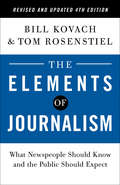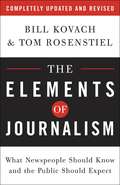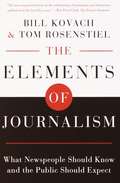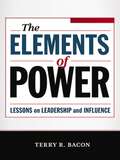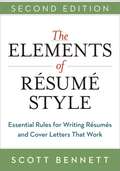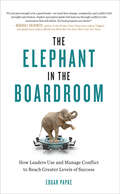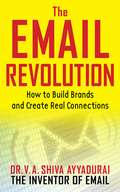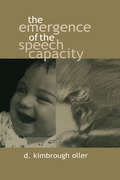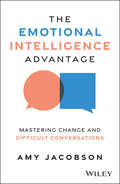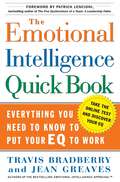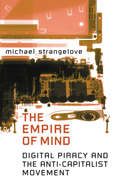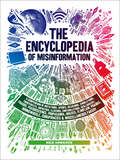- Table View
- List View
The Elements of Journalism, Revised and Updated 4th Edition: What Newspeople Should Know And The Public Should Expect
by Bill Kovach Tom RosenstielA timely new edition of the classic journalism text, now featuring updated material on the importance of reporting in the age of media mistrust and fake news—and how journalists can use technology to navigate its challengesMore than two decades ago, the Committee of Concerned Journalists gathered some of America&’s most influential newspeople and asked them, &“What is journalism for?&” Through exhaustive research, surveys, interviews, and public forums, the committee identified the essential elements that define journalism and its role in our society. The result is one of the most important books on media ever written—winner of the Goldsmith Book Prize from Harvard, a Society of Professional Journalists Award, and the Bart Richards Award for Media Criticism from Penn State University.Updated with new material covering the ways journalists can leverage technology to their advantage, especially given the shifting revenue architecture of news—and with the future of news, facts, and democracy never more in question—this fourth edition of The Elements of Journalism is the authoritative guide for journalists, students, and anyone hoping to stay informed in contentious times.
The Elements of Journalism: What Newspeople Should Know and the Public Should Expect
by Bill Kovach Tom RosenstielThe Book That Every Citizen and Journalist Should Read. "What this book does better than any single book on media history, ethics, or practice is weave [together] why media audiences have fled and why new technology and megacorporate ownership are putting good journalism at risk." --Rasmi Simhan, Boston Globe
The Elements of Journalism: What Newspeople Should Know and the Public Should Expect
by Bill Kovach Tom RosenstielIn July 1997, twenty-five of America's most influential journalists sat down to try and discover what had happened to their profession in the years between Watergate and Whitewater. What they knew was that the public no longer trusted the press as it once had. They were keenly aware of the pressures that advertisers and new technologies were putting on newsrooms around the country. But, more than anything, they were aware that readers, listeners, and viewers — the people who use the news — were turning away from it in droves. <P><P> There were many reasons for the public's growing lack of trust. On television, there were the ads that looked like news shows and programs that presented gossip and press releases as if they were news. There were the "docudramas," television movies that were an uneasy blend of fact and fiction and which purported to show viewers how events had "really" happened. At newspapers and magazines, celebrity was replacing news, newsroom budgets were being slashed, and editors were pushing journalists for more "edge" and "attitude" in place of reporting. And, on the radio, powerful talk personalities led their listeners from sensation to sensation, from fact to fantasy, while deriding traditional journalism. Fact was blending with fiction, news with entertainment, journalism with rumor. <P> Calling themselves the Committee of Concerned Journalists, the twenty-five determined to find how the news had found itself in this state. Drawn from the committee's years of intensive research, dozens of surveys of readers, listeners, viewers, editors, and journalists, and more than one hundred intensive interviews with journalists and editors, The Elements of Journalism is the first book ever to spell out — both for those who create and those who consume the news — the principles and responsibilities of journalism. Written by Bill Kovach and Tom Rosenstiel, two of the nation's preeminent press critics, this is one of the most provocative books about the role of information in society in more than a generation and one of the most important ever written about news. By offering in turn each of the principles that should govern reporting, Kovach and Rosenstiel show how some of the most common conceptions about the press, such as neutrality, fairness, and balance, are actually modern misconceptions. They also spell out how the news should be gathered, written, and reported even as they demonstrate why the First Amendment is on the brink of becoming a commercial right rather than something any American citizen can enjoy. <P> The Elements of Journalism is already igniting a national dialogue on issues vital to us all. This book will be the starting point for discussions by journalists and members of the public about the nature of journalism and the access that we all enjoy to information for years to come. <P>
The Elements of Negotiation: 103 Tactics for Everyone to Win in Each Deal
by Keld JensenComprehensive guide to mastering negotiation, based on 24 years of research The Elements of Negotiation provides readers with an easy-to-follow step-by-step approach to becoming exceptional negotiators in both their professional and personal lives. Grounded in 24 years of extensive research, studying the habits and techniques of 35,000 individual negotiators, the 103 steps provide a detailed roadmap for negotiation excellence, covering preparation, execution, and post-negotiation analysis. Backed by tested science proving the tips' efficacy, The Elements of Negotiation explores a wealth of real-world case studies and examples, with trends and predictions into the future of negotiation, and additional resources and training programs to further improve your negotiation skills. In this book, you'll learn: How to prepare for negotiations to achieve superior financial outcomes What to say—and not say—during any negotiation, big or small How successful negotiators achieve positive outcomes for both parties Why successful negotiators are usually successful in both their personal and professional lives With its research-backed approach and the expertise of Keld Jensen, an international authority on negotiation with countless accolades and clients like the Financial Times, Target, Government of Canada, and UCLA, The Elements of Negotiation is an invaluable resource for anyone looking to elevate their negotiation skills.
The Elements of Power: Lessons on Leadership and Influence
by Terry R. BaconWhat do a person's knowledge, expressiveness, history, character, and attraction have in common? Or his or her role, resources, information, network, and reputation? Each is a key to either personal or organizational power, and together they open the complex combination lock on the door of true leadership and irresistible influence. The Elements of Power combines the latest research on the nature of power all over the world with a handy self-assessment and invaluable insight into: How power works in organizations How people use and lose power The relationship between power and leadership What makes famous people powerful or what diminishes their power Sources of power and how to build each one Leading and influencing others more effectively Complete with "Portraits in Power" examining key business figures and world leaders alike, the full effect is an accessible and unprecedented pipeline to the many sources and types of internal and external power, including the most valuable of all: the power of will.
The Elements of Résumé Style: Essential Rules for Writing Resumes and Cover Letters That Work
by Scott Bennett<p>It's amazing the misinformation found in most resume books! Scott Bennett has hired hundreds of people in a variety of industries, and he knows firsthand what kind of resume sparks an employer's interest-and which ones fail. In <i>The Elements of Resume Style</i>, he warns against popular "tricks" that tend to backfire-and instead shows readers how to craft clear, compelling, targeted resumes and cover letters that actually work. <p>In this new edition, readers see that whether it's on paper or online, the rules are the same: use clear, dynamic language-and keep it short and focused. Now covering social media, the online application process, and more, this indispensable guide provides: <p> <li>More than 1,400 action words, statements, and position descriptions that help sell your skills and experience <li>Hundreds of words, phrases, and vague claims to avoid <li>Advice for handling employment gaps, job-hopping, and requests for salary history and requirements <li>Sample resumes, response letter, inquiry letter, informational interview request letter, references, and more <li>Surprising tips for acing the interview</li> <p> <p>Competition is intense no matter what your field, but this candid book's time-tested tools will make you stand out-and help get you the job you deserve!</p>
The Elements of Visual Grammar: A Designer's Guide for Writers, Scholars, and Professionals (Skills For Scholars Ser.)
by Angela RiechersA color-illustrated introduction to the basic principles of visual language that every content creator and consumer needs to knowThe right images capture attention, pique curiosity, and inspire viewers to stick around long enough to read any accompanying text. Nearly everyone today needs to use or understand images in communications of all kinds, from the most formal professional publication to the most casual social media post, and knowing the basics of visual language is essential for content creators and consumers alike. However, most people aren’t taught visual grammar unless they go into art- or design-related fields. The Elements of Visual Grammar explains image use in any media in practical terms for writers, scholars, and other professionals. Award-winning art director and design professor Angela Riechers offers a flexible set of principles and best practices for selecting images that work—and using them in the most persuasive way. The result is an indispensable guide for anyone who wants to learn how to work more successfully with images and words.Features more than 200 color illustrations—drawn from a wide range of styles, media, and eras—that demonstrate the principles of visual grammar and how images can support and enhance written contentDefines and illustrates the basic elements of images, describes how images function within text regardless of media, and explains how to choose images and integrate them with textIntroduces the practical, cultural, conceptual, and scientific factors that influence image useAnalyzes images by function and describes ways to employ symbolism, synecdoche, allegory, metaphor, analogy, and iconography
The Elephant in the Boardroom: How Leaders Use and Manage Conflict to Reach Greater Levels of Success
by Edgar PapkeA seven-step guide to effective leadership through confronting conflict and using its power to drive success.“When leaders fail to confront conflict, they become the “biggest elephant” in the room.”In a survey of more than 4,000 CEOs, executives, and managers, more than ninety percent admitted they were uncomfortable confronting or engaging in conflict.Yet leaders must realize that every conflict presents an opportunity to reach higher levels of performance. In The Elephant in the Boardroom, award-winning leadership psychologist Edgar Papke explores the unique and challenging relationship that leaders have with conflict, and offers the know-how needed to use conflict as the engine of innovation and creativity. As a result, you will learn how to act courageously and be better equipped to lead and win in today’s complex and turbulent world.The Elephant in the Boardroom will help you:Better understand the unique relationship leaders have with conflictGain the self-knowledge required to confront conflict and attain higher levels of leadership performanceLearn how to foster cultures of openness and higher accountabilityIdentify the sources of dysfunctional conflict to create constructive change effectivelyLearn to use a proven, seven-step model for effectively managing and leveraging conflictAre you ready to confront the “big elephant in the room,” and manage the elephants living and thriving in your organization?
The Elevated Communicator: How to Master Your Style and Strengthen Well-Being at Work
by Maryanne O'BrienDiscover your communication style and elevate consciousness at work to build trust, strengthen collaboration, relieve stress, and improve well-being. Our work lives revolve around effective communication. It is essential for cultivating trust and team collaboration, as well as strengthening our motivation and well-being at work. And with teams experiencing more anxiety, stress, and burnout than ever before, strong communication skills have never been more essential. The key to this clear and effective communication begins with understanding our own personal communication styles. Bringing our whole and authentic selves to work improves relationships and teamwork. The better we know what drives us, how we impact others, and how our wellbeing impacts our communication, the faster we can close communication gaps to build healthy, successful, and satisfying work lives and more intentional careers. Drawing on more than a decade of original research on communication tendencies and proven mindfulness and habit-formation techniques, Maryanne O&’Brien has developed a proprietary model of communication styles: Expressive, Reserved, Direct, or Harmonious. In The Elevated Communicator, you will find: -A self-assessment to discover your style -An in-depth style profile to strengthen self-awareness and help you play to your strengths -Strategies to manage your communication style under stress -Practices to improve your wellbeing and reduce conflict -Ways to care for your communication style and improve your wellbeing -Methods to flex toward other styles to communicate more effectively with people -Advice on building healthy, trusted, and productive working relationships Perfect for fans of StrengthsFinders 2.0 and Gretchen Rubin&’s The Four Tendencies, The Elevated Communicator is a &“refreshing, insightful, and user-friendly&” (Tara Peyerl, executive coach and success director, Salesforce) approach to develop daily practices to spiral up, raise consciousness, inspire accountability, and discover your full potential at work.
The Eloquent President: A Portrait of Lincoln Through His Words
by Ronald C. White Jr.Analysis of Lincoln's speeches and the events surrounding them.
The Email Revolution: Unleashing the Power to Connect
by V. A. Ayyadurai Leslie P. MichelsonIn 1978, fourteen-year-old technology prodigy V. A. Shiva Ayyadurai invented email. From there, he would go on to manage email for the Clinton administration and create email-sorting software that would be used by some of the largest companies in the world, including Nike, AT&T, Toyota, and JC Penny. He discovered that incoming emails offered countless opportunities to mine data and solidify relationships with citizens and customers--opportunities of which organizations everywhere were failing to take advantage.Through a series of case studies, this fascinating book demonstrates how organizations of all types and sizes can realize the infinite potential of email to strengthen their brands and reach their audiences in incredibly creative ways. From facilitating more effective and courteous customer service to mining useful information about their clients, from averting disaster by catching product defects early to understanding and managing their public image, companies will discover new and innovative uses for the contents of their inboxes. Don't miss another opportunity to connect with your clients. Let one of the great innovators of our time show you how to transform your info@ email account into a goldmine.
The Emergence of the Speech Capacity
by D. Kimbrough OllerRecent studies of vocal development in infants have shed new light on old questions of how the speech capacity is founded and how it may have evolved in the human species. Vocalizations in the very first months of life appear to provide previously unrecognized clues to the earliest steps in the process by which language came to exist and the processes by which communicative disorders arise. Perhaps the most interesting sounds made by infants are the uniquely human 'protophones' (loosely, 'babbling'), the precursors to speech. Kimbrough Oller argues that these are most profitably interpreted in the context of a new infrastructural model of speech. The model details the manner in which well-formed speech units are constructed, and it reveals how infant vocalizations mature through the first months of life by increasingly adhering to the rules of well-formed speech. He lays out many advantages of an infrastructural approach. Infrastructural interpretation illuminates the significance of vocal stages, and highlights clinically significant deviations, such as the previously unnoticed delays in vocal development that occur in deaf infants. An infrastructural approach also specifies potential paths of evolution for vocal communicative systems. Infrastructural properties and principles of potential communicative systems prove to be organized according to a natural logic--some properties and principles naturally presuppose others. Consequently some paths of evolution are likely while others can be ruled out. An infrastructural analysis also provides a stable basis for comparisons across species, comparisons that show how human vocal capabilities outstrip those of their primate relatives even during the first months of human infancy. The Emergence of the Speech Capacity will challenge psychologists, linguists, speech pathologists, and primatologists alike to rethink the ways they categorize and describe communication. Oller's infraphonological model permits provocative reconceptualizations of the ways infant vocalizations progress systematically toward speech, insightful comparisons between speech and the vocal systems of other species, and fruitful speculations about the origins of language.
The Emergent Organization: Communication As Its Site and Surface (Routledge Communication Series)
by James R. Taylor Elizabeth J. Van EveryToday's organizations face a wide variety of challenges, including such contradictions as maintaining unity of action while becoming increasingly diverse. Even the definition of organization is changing and evolving. In this monograph, the authors apply their academic and professional experience to address the notion of "organization," setting forth communication as the essential modality for the constitution of organization--explaining how an organization can at the same time be both local and global, and how these properties which give organization continuity over time and across geographically dispersed situations also come to be manifested in the day-to-day of human interpersonal exchange. As a radical rethinking of the traditional discourse approaches in communication theory, this book develops a conceptual framework based on the idea that "organization" emerges in the mix of conversational and textual communicative activities that together construct organizational identity. Applying concepts from the philosophy of language, linguistics, semiotics, system design, sociology and management theory, the authors put forth a convincing argument demonstrating the materiality of language and its constructive role in organization and society.
The Emerging Domain of Cooperating Objects
by Stamatis Karnouskos Daniel Minder Pedro José MarrónThis book provides a classification of current and future applications for the domain of Cooperating Objects. The book has been created with a very strong participation of the industry and taking into account current research trends and industrial roadmaps
The Emoji Code: The Linguistics Behind Smiley Faces and Scaredy Cats
by Vyvyan EvansDrawing from disciplines as diverse as linguistics, cognitive science, psychology, and neuroscience, The Emoji Code explores how emojis are expanding communication and not ending it.For all the handwringing about the imminent death of written language, emoji—those happy faces and hearts—is not taking us backward to the dark ages of illiteracy. Every day 41.5 billion texts are sent by one quarter of the world, using 6 million emoji. Evans argues that these symbols enrich our ability to communicate and allow usto express our emotions and induce empathy—ultimately making us all better communicators.The Emoji Code charts the evolutionary origins of language, the social and cultural factors that govern its use, change, and development; as well as what it reveals about the human mind. In most communication, nonverbal cues are our emotional expression, signal our personality, and are our attitude toward our addressee. They provide the essential means of nuance and are essential to getting our ideas across. But in digital communication, these cues are missing, which can lead to miscommunication. The explosion of emojis in recent years has arisen precisely because it fulfills exactly these functions which are essential for communication but are otherwise absent in texts and emails. Evans persuasively argues that emoji add tone and an emotional voice and nuance, making us more effective communicators in the digital age.
The Emotional Intelligence Activity Kit: 50 Easy and Effective Exercises for Building EQ
by Adele Lynn Janele LynnElevate emotional intelligence throughout your organization—and watch profitability, retention, and customer satisfaction soar!Know-it-all bosses, overcompetitive colleagues, and leaders who rarely leave their offices--common EQ problems such as these damage not just camaraderie, but also results. Because of this, managers are discovering now more than ever that emotional intelligence (EI)--knowing how to manage emotions, empathize, build relationships, and more--is a vital contributor to a company&’s success. But how does one go about persuading others to improve their EI?The Emotional Intelligence Activity Kit shows the way with 50 practical exercises to:Promote introspectionIncrease empathyImprove social skillsBoost influenceInspire purposeBring everyone on boardStudies have proven that emotional intelligence drives performance. But the problem has always been how to utilize this knowledge and inspire new ways of thinking among individuals.With The Emotional Intelligence Activity Kit, trainers, coaches, and organizational development professionals can now break through and trigger lasting EQ improvements to create thriving, successful organizations.
The Emotional Intelligence Advantage: Mastering Change and Difficult Conversations
by Amy JacobsonProven strategies for navigating hard conversations, building team resilience and managing business transformation In The Emotional Intelligence Advantage, leading expert Amy Jacobson shares a framework for resolving challenges in the workplace. How do you tackle tough conversations? How does your team react when a key process or system changes? And how can you overcome doubt and indecision to create a culture of alignment and trust? When it comes to modern leadership, you need to be aware of more than just the bottom line. You also need to apply emotional intelligence in how you manage people, processes and change. In this book, you'll discover a clear five-step process for empathetic, productive communication. Through real-world case studies, proven tools and actionable strategies, The Emotional Intelligence Advantage demonstrates how you can address conflict and facilitate change seamlessly. Embrace workplace challenges and focus on what you can control. Process emotions and effectively shift from defensiveness to solutions. Recognise your impact on others and build team resilience and emotional alignment. Ask the right questions to unify stakeholders and achieve shared goals. Apply strategies that drive progress, spark organisational transformation and deliver lasting results. A workplace thrives when people thrive. With this step-by-step framework for fostering emotional intelligence, you'll discover how to create a high-performing environment where each person feels safe and engaged. The Emotional Intelligence Advantage is a practical handbook for embedding emotional intelligence into your workplace effectively.
The Emotional Intelligence Quick Book: Everything You Need to Know to Put Your EQ to Work
by Dr. Travis Bradberry Dr. Jean GreavesAn accessible, how-to guide that brings focus to the unique skills that comprise emotional intelligence and incorporate these tools into your life.EMOTIONAL INTELLIGENCE: THE #1 PREDICTOR OF PROFESSIONAL SUCCESS AND PERSONAL EXCELLENCE In today's fast-paced world of competitive workplaces and chaotic personal lives, each of us is searching for effective tools that can make our schedules, behaviors, and relationships more manageable. The Emotional Intelligence Quickbook shows us how understanding and utilizing emotional intelligence can be the key to exceeding our goals and achieving our fullest potential. Authors Bradberry and Greaves use their years of experience as emotional intelligence researchers, consultants, and speakers to revitalize our current understanding of emotional intelligence. They have combined their latest research on emotional intelligence with a quick, easy-to-use format and cut-to-the-chase information to demonstrate how this other kind of "smart" helps us to decrease our stress, increase our productivity, understand our emotions as they happen, and interact positively with those around us. The Emotional Intelligence Quickbook brings this concept to light in a way that has not been done before -- making EQ practical and easy to apply in every aspect of our daily lives. The Quickbook will help you to: -Engage the four unique areas of EQ: self-awareness, self-management, social awareness, and relationship management -Increase your EQ through the use of these skill-building techniques -Apply your EQ at work to develop leadership skills and improve teamwork, making you a better manager and a more desirable employee -Practice your EQ outside the office environment to benefit your relationships with loved ones, making you a better partner and parent -Access the link between your EQ and your physical well-being to improve your overall health -Measure your current EQ through access to the authors' bestselling online Emotional Intelligence Appraisal
The Empathy Factor: Your Competitive Advantage for Personal, Team, and Business Success
by Marie R. MiyashiroBuilding on the latest research in brain science, emotional intelligence, and organizational theory, an award-winning communication and organizational strategist answers questions about the true definition of empathy. This groundbreaking exploration into business productivity and office management offers both real-world insights and practical ways to build transformative empathy skills organization-wide. It shows how learning about and teaching empathy in the workplace can improve productivity, innovation, and profitability. The guide also provides an innovative framework to help leaders meet the six universal needs of the organization itself while also respecting those of individual employees and customers.
The Emperor and the Army in the Later Roman Empire, AD 235-395
by Mark HebblewhiteWith The Emperor and the Army in the Later Roman Empire, AD 235–395 Mark Hebblewhite offers the first study solely dedicated to examining the nature of the relationship between the emperor and his army in the politically and militarily volatile later Roman Empire. Bringing together a wide range of available literary, epigraphic and numismatic evidence he demonstrates that emperors of the period considered the army to be the key institution they had to mollify in order to retain power and consequently employed a range of strategies to keep the troops loyal to their cause. Key to these efforts were imperial attempts to project the emperor as a worthy general (imperator) and a generous provider of military pay and benefits. Also important were the honorific and symbolic gestures each emperor made to the army in order to convince them that they and the empire could only prosper under his rule.
The Empire of Mind
by Michael StrangeloveWhere many critics see the Internet as an instrument of corporate hegemony, Michael Strangelove sees something else: an alternative space inhabited by communities dedicated to anarchic freedom, culture jamming, alternative journalism, and resistance to authoritarian forms of consumer capitalism and globalization. In The Empire of Mind, "Dr. Strangelove," the scholar Canadian Business referred to as the "acknowledged dean of Internet entrepreneurs" and Wired called "the Canadian guru of Internet advertising," presents the compelling argument that the Internet and new digital communication technology actually undermine the power of capital, producing an alternative symbolic economy.Strangelove contends that the Internet breaks with the capitalist logic of commodification and that, while television produces a passive consumer audience, Internet audiences are more active, creative, and subversive. Writers, activists, and artists on the Internet undermine commercial media and its management of consumer behaviour, a behaviour that is challenged by the Web's tendency toward the disintegration of intellectual property rights. Case studies describe the invention of new meaning given to cultural and consumer icons like Barbie and McDonald's and explore how novel modes of online news production alter the representation of the world as it is produced by the mainstream, corporate press.In the course of exploring new media, The Empire of Mind also makes apparent that digital piracy will not be eliminated. The Internet community effectively converts private property into public, thereby presenting serious obstacles for the management of consumer behaviour and significantly eroding brand value. Much to the dismay of the corporate sector, online communities are disinterested in the ethics of private property. In fact, the entire philosophical framework on which capitalism is based is threatened by these alternative means of cultural production.
The Encyclopedia of Business Letters, Faxes, and E-mail
by Regina Anne Kelly Robert W. BlyA revised, updated edition with more than three hundred sample letters, memos, and e-mails, and new tips on how to use and adapt them.The era of long, leisurely letters is gone—no one has time to waste in today’s workplace, and communication revolves around fast faxes, instant e-mails, crisp memos, and concise messages. That’s where The Encyclopedia of Business Letters, Faxes, and E-mails can help—whether you’re starting out in the corporate world or just want to feel more confident in your daily business writing.You’ll find more than three hundred sample letters, memos, and e-mails you can use as-is or adapt for your own purposes. Letters are organized into chapters by category, and a detailed table of contents guides you quickly to the one that best suits your needs. Each is accompanied by useful information, including how to format, design, print, and deliver your correspondence for best effect. This revised edition contains more help than ever, with:• An expanded introduction to letters, faxes, and e-mails, with new tips on the best use of each• Guidance on the nuances of e-mail, including how to avoid common pitfalls• Dozens of additional sample e-mail formats to meet today’s communication needs•. More focused directions for organizing your thoughts and composing even the toughest kinds of correspondence
The Encyclopedia of Misinformation: A Compendium of Imitations, Spoofs, Delusions, Simulations, Counterfeits, Impostors, Illusions, Confabulations, Skullduggery, ... Conspiracies & Miscellaneous Fakery
by Rex Sorgatz“In an era of ‘alternative facts,’ Rex Sorgatz’s The Encyclopedia of Misinformation helps put things in perspective.” —Fast CompanyThis compendium of misinformation, deception, and self-delusion throughout history examines fakery in the context of science and advertising, humor and law, sports and video games, and beyond. Entries span eclectic topics: Artificial Intelligence, Auto-Tune, Chilean Sea Bass, Clickbait, Cognitive Dissonance, Cryptids, False Flag Operations, Gaslighting, Gerrymandering, Kayfabe, Laugh Tracks, Milli Vanilli, P.T. Barnum, Photoshopping, Potemkin Villages, Ponzi Schemes, Rachel Dolezal, Strategery, Truthiness, and the Uncanny Valley. From A to Z, this is the definitive guide to how we are tricked, and how we trick ourselves.“Occasional salty language and pop-culture references make this compendium of 300 short entries a delightful mix of high- and lowbrow.” —Booklist
The End of Obscenity: The Trials of Lady Chatterley, Tropic of Cancer & Fanny Hill by the Lawyer Who Defended Them
by Charles RembarWinner of the George Polk Award: Charles Rembar's illuminating account of overturning America's obscenity laws and protecting literature from censorship Up until the 1960s, depending on your state of residence, your copy of Henry Miller's Tropic of Cancer might be seized by the US Postal Service before reaching your mailbox. Selling copies of Cleland's Fanny Hill in your bookstore was considered illegal. Lady Chatterley's Lover by D. H. Lawrence was, according to the American legal system, pornography with no redeeming social value. Today, these novels are celebrated for their literary and historic worth. The End of Obscenity is Charles Rembar's account of successfully arguing the merits of such great works of literature in front of the Supreme Court. As the lead attorney on the case, he--with the support of a few brave publishers--changed the way Americans read and honor books, especially the controversial ones. Filled with insight from lawyers, justices, and the authors themselves, The End of Obscenity is a lively tour de force. Racy testimony and hilarious asides make Rembar's memoir not only a page-turner but also an enlightening look at the American legal system.
The End of the Job Description: Shifting From a Job-Focus To a Performance-Focus
by Tim Baker'That's not my job.' If you don't want your employees to say that, why do you start your relationship by giving them a narrow task and competency focused description of their job? We need people to fulfil many different roles at work yes the need to do their job, but they also need to contribute positive energy, collaborate, and take personal reasonability for innovation and personal development. How do they fit into a traditional job description? It is futile persevering with the job description borne out of the scientific management movement one hundred years ago. The world of work is vastly different to the assembly lines of the Ford Motor Company of the early twentieth-century. Building on the phenomenal success of The End of the Performance Review, Baker examines four essential 'Non-Job' roles that all employees must fulfil and shows how to create meaningful role descriptions that can help you recruit better people and enable them to deliver better results.
